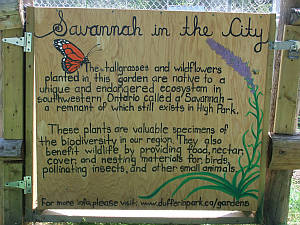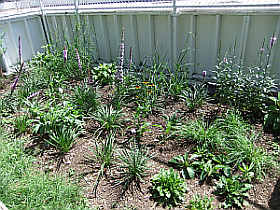
Pages in this Folder:

Related Folders:
See also Department Site Map

This Gardens subsite developed with the kind assistance of the Toronto Parks and Trees Foundation
Comments?
For the basics, see
- Website & Privacy Policies
- How To Get Involved
- The Role of the Park
Search options:
Department Site Map
Custodians:
Savannah in the City
This garden is on the north side of the rink fence, in the northwest corner of the park.

Savannahs are open areas in the forest with scattered trees (usually oak or pine) whose discontinous tree canopy allows enough light in to support wildflowers, shrubs and grasses normally found in tallgrass prairies. Unlike meadows - which tend to evolve into forest as a result of the natural succession of species - savannahs are considered to be stable plant communities because of the unique ability each of the plants has to regenerate after forest fires. They are incredibly biodiverse habitats both in terms of the flora within them and the fauna that they support. Unfortunately they are also endangered in Ontario, as both urban and agricultural areas have gradually swallowed them up.
Toronto lies at the northeastern tip of the original range of Ontario's savannahs. Today, all that remains in this area is a small remnant in High Park which is now carefully monitored and maintained. In fact, prescribed burns are performed annually in order to mimic the natural processes that historically sustained it. Here at the park, we have decided to restore and naturalize a long-neglected garden on the north side of the hockey rink by creating a representative savannah-esque plant community as an educational tribute to this unique and endangered ecosystem that is both historically and ecologically significant in Toronto. It is also a wildlife garden; each of the species planted here is providing a valuable service to pollinating insects, birds, and small animals. For details on each of these plants and the creatures they attract, see below.
Savannah Garden Plant List | |
 Anise Hyssop 1. Anise Hyssop - Agastache foeniculum – attracts: long-tongued bees, butterflies, hummingbirds |
 Big Bluestem 2. Big Bluestem - Andropogon gerardii – attracts: birds, butterflies, small mammals |
 Black-eyed Susan 3. Black-eyed Susan - Rudbeckia hirta – attracts: bees, wasps, flies, butterflies, birds, beetles |
 Columbine 4. Columbine - Aquilegia canadensis – attracts: birds, butterflies and butterfly larva, bees, hummingbirds |
 Cup Plant 5. Cup Plant - Silphium perfoliatum – attracts: long and short-tongued bees, bee flies, flies, butterflies, birds (drink water from the cup formed by the leaves) |
 Dense Blazing Star 6. Dense Blazing Star - Liatris spicata – attracts: birds, butterflies, hummingbirds, bees |
 Evening Primrose 7. Evening Primrose - Oenothera biennis – attracts: moths, honeybees, bumblebees, hummingbirds |
 Foxglove Beardtongue 8. Foxglove Beardtongue - Penstemon digitalis – attracts: long-tongued bees, butterflies and moths |
 Grayheaded Coneflower 9. Grayheaded Coneflower - Ratibida pinnata – attracts: bees, wasps, flies, butterflies, beetles, birds, and small mammals |
 Indian Grass 10. Indian Grass - Sorghastrum nutans – attracts: birds, butterflies, small mammals |
 Little Bluestem 11. Little Bluestem - Schizachyrium scoparium – attracts: birds, butterflies, small mammals |
 Meadow Blazing Star 12. Meadow Blazing Star - Liatris ligulistylis – attracts: Monarch Butterfly, Goldfinch |
 Obedient Plant 13. Obedient Plant - Physostegia virginiana – attracts: bumblebees, butterflies |
 Prairie Smoke 14. Prairie Smoke - Geum triflorum – attracts: bumblebees, butterflies |
 Purple Milkweed 15. Purple Milkweed - Asclepias purpurascens – attracts: longtongued bees, butterflies |
The Savannah garden near the end of its first summer. Click on the photo to see an enlarged image. |
This garden renovation could not have been done without the help of a grant from the Parks and Trees Foundation, and the assistance of Clement Kent, a York University biologist and promoter of pollinator gardens, the Parks Department, and most importantly, our volunteers.




 Printer friendly version
Printer friendly version
